Global Lighting Suppliers Count on Green Products to Beat Downturn
2009/01/13 | By Ken LiuAt the Hong Kong International Lighting Fair 2008, held in late October, a large number of the 28,210 attending buyers were eagerly searching for energy-saving products, notably LED lights, compact fluorescent lamps (CFLs) and solar lighting systems. Suppliers of green products at the show were confident that such products would remain in the spotlight at a time of energy shortage and growing environmental awareness.
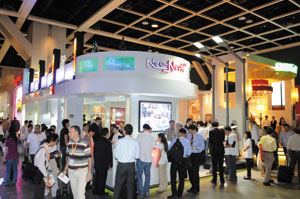
Despite the global economic turmoil, the total attendee turnout at the 2008 show was up from 2007's 27,899 and 2006's 25,045. At a breakfast press conference, Raymond Yip, Assistant Executive Director in charge of exhibitions at the Hong Kong Trade Development Council, which organized this year's show, noted that this year many American and European buyers were hesitant to attend. "However, buyers from emerging markets like mainland China and eastern Europe increased considerably in number," he said.
Insiders worried that in tough times, consumers in crisis-battered markets would become more cost conscious, dampening demand for lighting products. When asked about his opinion of the U.S. lighting market in 2009, a U.S. buyer commented: "If lucky, the market will be flat. If not, the market will plunge 20%."
This year, energy saving took center stage at the lighting fair. Many exhibitors displayed energy-saving products and more buyers were shopping around for green products than in previous years. Still the segment is beset by a buyer's dilemma: energy-saving products save money by reducing electricity costs; but they cost more up front, making cash-strapped consumers wary of plunking out now for savings down the road.
This year, the show drew over 1,570 exhibitors from 33 economies, more than the 1,344 and 1,217 exhibitors who attended in 2007 and 2006, respectively.
The Hong Kong lighting fair is No.2 globally and first in Asia in terms of exhibitor and buyer turnouts. It has become a must-go place for sourcing lighting products.
Getting the LED Out
LED lighting is a rising star in the industry due to its lower energy consumption, lack of toxins and ultraviolet rays, and long-life. In recent years, the technology has made impressive progress. This year, Seoul Semiconductor Co., Ltd. of South Korea exhibited its "Ariche" alternating current (AC) LED emitter, which can be directly plugged into a household 220V outlet without a direct-current (DC) converter. According to Eric Choi, sales manager of the company's Shenzhen office, the company expects to increase the LED emitter's luminosity to 100 lumens per watt by the end of this year, up from 80 lumens per watt now.
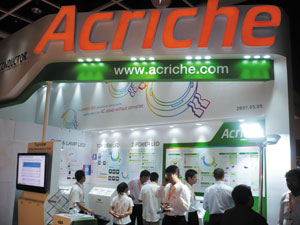
"Seoul Semiconductor is the world's first LED chipmaker to introduce commercialized AC LED lights. When its efficacy reaches 100 lumens per watt, it will replace DC devices and traditional lighting products. We plan to quickly bag the lion's share of the AC LED market by bringing down prices with big volume output," said Choi.
The company strings four 50V chips on a die to make a basic 2.4-watt AC LED emitter, which has been certified with a UL approval. "We're the first AC LED maker to win the approval and our CE and TUV certifications are pending now," Choi said. His company plans to debut a 1W LED light in early December this year. The upcoming emitter is designed to deliver color-rendering index of 85, compared with 70 CRI for its cold white cousin and 80 for its warm white predecessor.
Choi noted that due to structural factors, his company's AC LED produces more heat than a DC LED. "So, efficient thermal dissipation is especially important in the design of lighting modules when using LEDs. We've suggested to our AC LED customers that they should keep the PN junction temperature at 80 degrees centigrade," he said. The die is bundled on copper substrate, which is noted for excellent thermal conductivity. The company supplies blue emitters and green emitters and plans to introduce red emitters sometime in 2009, according to Choi.
Seoul Semiconductor developed its LED technology in 2005. The company now aims to use the patented technology to become the world's No.3 LED chipmaker in 2010 with projected revenue of US$1.3 billion. "Our goal is based on the pledges of leading lighting manufacturers around the world to use our Ariche devices," Choi said.
Choi said his company was the No.6 LED chipmaker in 2007 with global revenue of US$280 million, trailing Nichia, Stanley, Lumiled, Osram and Citizen. "We expect to gain one position up in 2008 by increasing our global market share to 7.8%. Last year, we had 5.9%, a jump from 2006's 3.2%. We were the only chipmaker to double market share in the 2006-2007 period. Lumiled stayed flat at 6.3% whereas the others lost shares," the sales manager said. Seoul was founded in 1987.
Citizen Lights Up
Citizen Electronics (China) Co., Ltd. of Japan exhibited high-power LED packages for lighting applications. The company, a subsidiary of Citizen Watch Co., Ltd. of Japan, began selling white lighting LEDs in 2002 in partnership with Nichia. Previously, Citizen's major LED product line was backlight modules.
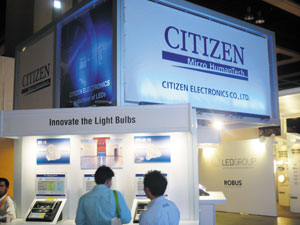
"We use Nichia's chips and phosphor to make LED emitters. The partnership has helped us both to boost market share. We now produce high-power LEDs for lighting in Japan and LED backlight modules for mobile phones in China," said Naoya Sato, director and general manager of Citizen China.
Sato's company has introduced LED emitters for indoor and outdoor lighting as well as refrigerators. He said his company's high-power emitters boast thermal resistance as low as 2.4 degrees centigrade per watt and cover five color temperature ranges from 2900 K to 6300 K. All of the company's emitters are multi-chip packages, with 16-chip emitters being the largest single package. "The 16-chip package gives off 1,150 lumens of light output and is designed to replace MR16 halogen lamps," Sato noted.
Europe and North America are the major export markets for Citizen's lighting LEDs. But Sato felt that China would become his company's largest market for the emitters given the huge number of foreign lighting manufacturers operating in China. "They are all potential customers of Citizen," he said.
For Citizen's LED lighting business, the ongoing global financial turmoil has not become an issue. "Our LED shipments are still small, so we haven't felt the impact of the crisis as much as those in other sectors," he explained.
Eco-friendly
BJB GmbH & Co. KG of Germany, a world leading lamp-components maker founded over 100 years ago, exhibited eco-friendly and user-friendly technologies at the Hong Kong lighting show. Among them are the GR14q and GX5 fluorescent holders, both of which are co-developed by BJB and Philips.
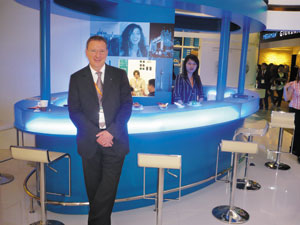
The GX5 is specifically designed to hold the two flat electrode pins of Philips Mater's TL5 lamp tubes, noted for their ultra high illumination output. The earlier versions are available only to fit the round pins of T5 lamp. The GX5's other unique advantages include its slot-and-twist fix structure and an auxiliary twist pad.
These products underscore the company's quality and technique advantage. "For us, the most important things are quality and high automation in Germany, which make us competitive," said Hans Hagemann, BJB's Non-Executive Director-sales.
To ensure top quality, the company makes its lamp holders from thermal plastic materials like PC. According to Hagemann, PC and other thermal plastics used in the company's lamp holders are ideal materials for resisting heat generated by fluorescent lamps. They are also recyclable. The company's data shows PC can resist as much as 110 Degrees centigrade. Its PBT lamp holder can resist 180 degrees, the PET holders can handle 210 degrees, the PA version 120 degrees, and PPS models 240 degrees.
The company has a wide range of energy-saving solutions including LED components. Hagemann said his company joined the LED business around a year ago and began mass-producing LED components recently. "LED is the latest technology. In addition to LED components, we have energy-saving components for energy-saving bulbs and fluorescent lamps," he stressed, referring to products like the GR14q and GX5.
Hagemann was optimistic about LED lighting. He said: "LED lighting already has a market share. It is not just a product with future potential. In 10 to 15 years, it will grow considerably to account for maybe 30 or 40% of the lighting business. Nobody can exactly foretell right now."
Even the financial crisis, Hagemann felt, would not take serious toll on the LED market although the rising light source remains expensive relative to generic light sources used today. "The crisis, I think, will not have much influence on lighting market because all energy-saving products including LED lamps are a topic of discussion in hard times. Over the long term, energy-saving progress in every luminary category will not be hampered significantly by the crisis. During hard times, consumers reduce spending on expensive lights. This is normal in the lighting market. Although it [LED lighting] is expensive today, it will get cheaper. That's for sure," he said.
Facing the economic headwinds, Hagemann stressed, BJB will expand market share through further automation and more cost-effective production and administrative operations. "Of course, these are our primary measures when dealing with market downturn," the BJB executive said.
BJB produces its LED lamps both in Germany and China. Products requiring labor-intensive assembly work are made in China and the company's fully automated production is handled in Germany. The financial crisis, Hagemann stressed, would not compel his company to change its current production strategy. "Definitely we will not change status quo because of the financial crisis. Although we will increasingly shift labor-intensive production to China, that is not due to the crisis but a normal cost-efficient strategy," he stressed.
Like many manufacturers, Hagemann has already felt a business slowdown. He associated the downturn mostly to recession of homebuilding industry worldwide. "We're 'a little bit' connected to that because houses need lights. If houses are not built in sufficient quantity we are naturally going to suffer," he explained.
He believed the company would "catch up" to the market again if the market plunge slows down next year. "If the economy returns to normal, not necessarily to its peak, I think we can catch up quite soon because people are now anxious to give us orders. They are holding back now because of the lack of market transparency at this moment. Now it just a matter of time," he commented.
Hagemann pointed out that BJB is 140 years old and has gone through many huge global crises over the years, including two world wars and the crisis in the 1920s. "As a healthy company, we have survived the past crises and will of course survive this ongoing crisis. Although the crisis will have a deep impact on the lighting industry, I think in general manufacturers like us can weather it," he stressed.
Diversifying markets, Hagemann said, had helped the company minimize damages from the crisis. He conceded that sales to the US, where BJB has a considerable market presence, have been visibly affected, but in other markets, the impact has been less pronounced.
Hagemann said it is not sure when the financial crisis will come to an end, but he hopes that the market will rebound sometime in the second half next year.
Although the company also makes its products in China, it never sources "sensitive materials" from China for its products. This is to ensure that its products are reliable and free from toxins.
Green Mood
Philips also promoted energy saving technologies for home lighting at the show this year. The company touted its "Eco Mood" line of products, including T5 fluorescent lamps. "All of these products save energy. For instance, the T5 comes with an electronic ballast inside so it can start up flicker free and instantly," said Eric de Boer, Product Portfolio Manager at Philips Consumer Luminaires (Shenzhen) Co., Ltd.
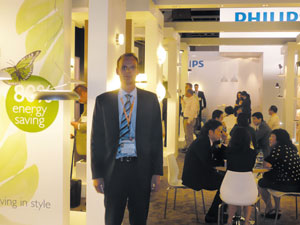
Energy saving is also a selling point on Philips decorative lighting fixtures, which Boer stressed are compatible with 95% of the energy-saving lamps on the market, including Philips Tornado compact fluorescent lamp. "It is a very high quality energy saving lamp with very good rendering. Also, it has a high light output," he noted. According to Philips data, the lamp's color rendering index (CRI) is 83 and its luminous efficacy is 63 lumen watts at 100 hours.
Absent from the Philips display this year was the company's LED luminaire collections at the Hong Kong show although it had readied them. "We will introduce them in the third quarter next year. For fear that the long time span before the introduction would give copycats the chance to copy the latest collections we do not want to show them here now," he said. But Boer showed a catalog book compiling the new collections to only selected visitors including CENS.
In the catalog book is its "Latino" collection of household luminaires, which Boer said features high light output and long life span of around 20 years or 50,000 hours. This collection, he added, goes to upscale market, with retail price going from70 euro (US$89 at 1 euro: US$1.28) to 500 euro (US$640) apiece. "Generally speaking, 200 euro is the median price level that European consumers are easy to accept. But people are willing to go above that line because the design, finish, quality and technique used inside are much better. Also, you must not forget this is an energy saving collection, which uses 80% less energy. So, consumers can earn back their investments in the lamps," Boer stressed. The collection is mainly composed of ceiling lights, table lamps, spotlights, desk lights and recessed lights, many of which have won design awards.
Boer acknowledged that high LED prices prompted Philips to emphasize other types of energy-saving lamps for the time being. "However, LED prices will drop very fast and at some point in time prices of LED will be at the same level as energy-saving lamps'. It means the end of energy-saving lamps will come soon and LED will take over. The development is going very fast as lumen per watt of LED is increasing rapidly. Lumen-per-watt technology has reached a peak for energy-saving lamps but is just starting off for LED lamps," Boer analyzed.
Nevertheless, Philips did not disappoint attendees who were eager to have a glimpse into its LED lighting technology. An intelligent LED mood lighting system codenamed "LivingColor" at its stand drew much attention for its illumination of 16 million unique colors, all of which are controlled via an attached wireless RF remote.
Boer said he had not yet felt the financial crisis although his company would probably feel it. "You have to recognize that there is always luminaire demand only when people keep moving from house to house. If they stop moving, it is of course a challenge [to luminaire manufacturers]. For now, luminaire prices are still at affordable levels. They are not TVs, on which you have to spend thousands of dollars. So, there are still quite a lot of people willing to invest in luminaires." he added.
Europe remains Philips Consumer Luminaires' major market, with Asia and Latin America on its market-expansion map, according to Boer. The bulk of production is in mainland China.
Mercury Security
Neonlite Electronic & Lighting (HK) Ltd. exhibited a full range of energy-saving lamps and an eco-friendly technology dubbed as "Amalgan" solid metal alloy inside its fluorescent lamps. "The main feature of Amalgan is it keeps the mercury inside it from evaporating when it comes out of CFLs [compact fluorescent lamps] burned or cracked. So, you could still clean it up without worries of inhaling toxic mercury gas. But when conventional CFLs get broken, you have to immediately evacuate from the room because the liquid mercury inside them will evaporate into toxic gas soon," said Ferrand Guy Cunningham, senior marketing communications officer of the company, which owns the "Megaman" brand name.
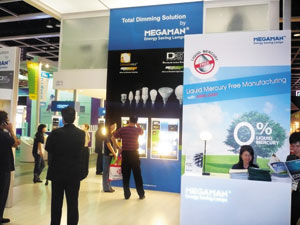
"The other thing is that when a consumer accidentally disposes a Megaman CFL into a landfill, the mercury will not poison the landfill because the mercury is intact inside Amalgan. So, we are actually reducing pollution. Even though we still have mercury inside Amalgan, the mercury level is kept under two milligrams. You have less mercury inside the lamps, yet the lamps deliver much more illumination," Cunningham reported. The company started using Amalgan technology last year.
His company's energy-saving lamps include dimmable types, instant full lit-up types and three-step and four-step density-increment types.
Fixated on Energy-saving
Brilliant AG, which was founded 50 years ago in Germany by the British National Lighting Co. (NLC) Group to supply indoor and outdoor lighting fixtures, displayed energy-saving fixtures at this year's show. Over half of fixtures were equipped with seven-watt compact fluorescent bulbs and the remaining were installed with incandescent bulbs. "Next year, probably all of the fixtures at our stand at this show will completely go with energy-saving lamps," commented sales development manager Maarten Schoots.
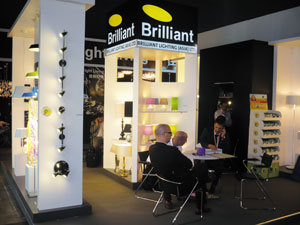
The company is following the energy-saving trend by offering lighting fixtures that can use energy-saving lamps, including fluorescent. "And we are moving in the direction of LED development and looking for partners who are strong in electronics or engineering sectors to create modules that can be useful for lighting fixtures. So, what we're doing is not only producing products but also offering concepts, especially energy-saving concept," Schoots stressed.
Schoots was confident that energy-saving lamps would completely replace incandescent lamps. "It will happen. The question is when. I think it will happen sooner rather than later. The lower-energy consumption, less heat, higher lumen-watt ratio, and instant light-up of energy-saving lamps make it senseless not to use the lamps. Governments in major economies are pushing the use of energy-saving lamps. I think there is no problem any more in not using incandescent lamps. Incandescent lamps waste 90% of the electricity as heat. Its terribly inefficient," he said.
Schoots boasted that Brilliant has a full assortment of styles covering both lower and high-end markets. "On the high-end front, we're creating alternative brands and beautiful designs. These upscale products differ in shape from DIY types," he said. The company's low-end products carry retro 17th century styles in colors including orange, lime, cream, pink and blue. "So, you see table lamps here already in retro designs and colors. You can extend this range to pendant and floor lamps. So, retro is an interesting trend," he adds.
Instead of using bright colors, Brilliant began using more earthy colors, including brown and gray colors with motifs on the colors. "So, we are closely following the furniture market and wall-decoration market. And we are closely watching color trends and patterns that are used on wall decorations or textiles," Schoots noted.
Schoots said that in Europe a new lighting trend usually starts in the western countries like the Netherlands and moves eastwards. "What is attractive in the Netherlands this year will become attractive in Germany next year. Then, it slowly moves eastward. Scandinavia is a little different and the UK is very different. The UK is around three years behind," he analyzed.
According to Schoots, Brilliant has felt the impact of the global economic recession and seen turnover slip. "We're one of the strongest lighting manufacturers in Europe. The average amount of money spent by consumers in DIY stores is going down, which means instead of buying expensive luminary fixtures they buy less-expensive fixtures. So, our average turnover per buy is slightly less and under downward pressure," he noted.
The company has taken measures to address the difficulty. "We are trying to become a lean and mean organization. So, we're cost driven. Secondly, we're trying to develop other markets that have fewer problems and are growing like Eastern Europe and Russia. Old markets, like the UK and Spain, have high sales volume. To compensate for falling sales levels in these markets, we have to move some volume to growing markets," Schoots noted.
Sourcing for Eastern Europe
Laszlo Kovacs, director of Hungarian trading company Elektrotech Trade Ltd., is the first-time visitor of the Hong Kong show. The company, founded in 1992, imports electronics components for whole sellers in the country. Optimistic about the Hungarian lighting market, he has recently added lighting electronics to the company's purchasing list.
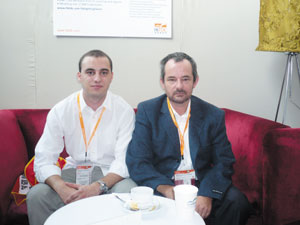
However, Kovacs conceded the financial crisis had affected his country. "The economy is not good and things are getting worse now in Hungary as a result. Worst of all, Hungary has not joined the euro system but is always compared with other European Union members. It's a problem now. I think the crisis has put a damper on all kinds of business now. Hopefully, things will change for the better soon," he said. But, Kovacs reported the downturn had not yet affected his business although it had clouded many other businesses.
Regardless of the financial tsunami, Kovacs would buy more products this year than last year because the company "has found more and more suppliers and business. "Like consumers in other countries, consumers in Hungary always want new products to choose from. So, you need to have more and more products to offer," he said.
Kovacs was sourcing products at the Hong Kong show because electronics components cost more to make in Hungary than in any non-Japan Asian country. "We buy from China, Taiwan and Hong Kong," he noted. In spite of China's disgraceful image as an exporter of poisonous products like toys, drugs and diary products over the past year, Kovacs said electronics components were not among the tainted products and his company would go on buying from China. "We buy these products from different countries depending on product quality. For instance, we buy products that require quality and thorough inspections from Taiwan," he said. The company began sourcing from Taiwan in 1999.
Buying for Dubai
Ahmed S. El Sadek, general manager of Seasons Electrical Trading L.L.C. of U.A.E., was searching for lights for new public-work projects like constructions of new hotels in his country. The Middle Eastern country's thriving tourist industry is offering lighting importers like Sadek a good opportunity to prosper. "The lighting business in Dubai is booming now. There is a lot of construction in Dubai, both underway and on the drawing board. "
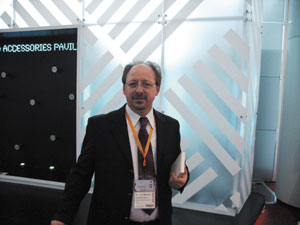
He said the crisis had not affected Dubai. "The government's public-work projects are running things and not likely stop at least until 2015. That's a long-term strategy. The Dubai stock market has lost 5%, but it has nothing to do with the local market. The local market is still profitable. So, the stock market plunge is not fair. It's all because of the international market," he said.
Trimming the Electricity Bill
A first-time visitor, Martin Sabbagh, managing director of Argentinean lighting importer PARNA 201, was searching for energy-saving products like LEDs at the Hong Kong show. "Electricity is quite expensive in Argentina. So, I'm searching for energy-saving lamps to help our consumers reduce their electricity bill," he noted.
According to Sabbagh, the Argentinean government is providing subsidies to encourage people to use energy-saving lamps. "Energy saving is an early-phase trend in my country now," he said.
"I'm going to buy a large volume of lamps. We have many new construction plans in Argentina like apartments and shops, which always need lights," he said. However, he conceded lighting demand in Argentine has fallen off from the level of five years ago. "It's all because of the financial crisis. Now, the Argentinean economy is going down little by little from its latest peak," he added.
Sabbagh was searching for products in Asia instead of in his home country not just because of the cost factor but also because of the wide variety of products supplied by Chinese manufacturers. "Manufacturing costs in Argentina are lower, but we do have the variety that Chinese manufacturers can supply. Here I can find favorable prices. So, I decided to attend this show for the first time," he noted.
Sabbagh noted that the Argentines like European-style lighting products as the country is deeply influenced by Spanish culture. "I can see all the products at this lighting show," he said.
Big-box Buyer
Kevin P. Sullivan, product development manager of the U.S. DSI Industries' Asia Operations, was bullish about his company's business because his company mostly deals with gigantic retailers like Wal-Mart, Home Depot and Costco. "We are doing quite well because consumers traditionally spending U$150-300 on table lamps and floor lamps in the past are now shopping at Wal-Mart, Home Depot and Costco," he said.
"When the economy is going down, business at Wal-Mart goes up. While we are maintaining higher-end customers, our revenue from customers of lower-end products in the lighting business is rising. For us, procurement sentiment in lower-end products is quite strong now," he said.
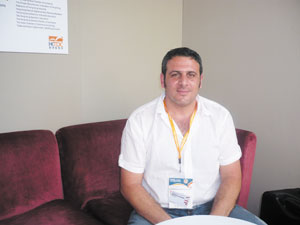
Subsidized Demand
An unnamed buyer from South Africa pointed out that his country is heavily pushing the use of energy-saving products, notably LED lighting powered by solar, to address the problem of energy shortages. "We are subject to regulations that utilities cut power supply to certain areas on a daily basis. So, we're moving into the solar-lighting field because we have an abundance of sunlight in South Africa and we cannot waste this resource," he said.
The buyer was searching for LEDs and energy-saving products at the Hong Kong show. His company, he noted, develops new designs and contracts manufacturers in China to make them.
His company started buying energy-saving products in 1996 to capitalize on government subsidies for energy-saving products. "We're one of the leading companies in South Africa to pioneer the use of energy-saving products," he reported. "Everybody is spending on energy-saving products to cut down their electricity bill," he said.
The buyer, like other South African homegrown lighting suppliers, is facing intensive competition from Philips and Osram. "Philips and Osram products were very expensive until two years ago when they started outsourcing from China. They have become competitive since then," he said. The buyer stressed that the competition is not a question of quality or brand but a question of the need to have energy-saving products at decent prices. "But, we never comprise on quality because we have our own regulatory body-the South Africa Bureau of Standards. They set standards for energy-saving products," he said.
The global recession has hit South Africa equally hard, triggering a 40-50% devaluation of the local currency against the U.S. dollar, according to the buyer. "Fortunately for us and our competitors, we're all competing on an equal footing because we have the same problem. If it was unique to us, we would be out of market," the buyer said.
The buyer noted that the South African economy has declined immensely over the past two years. However, quite a lot foreign investment continues to move into South Africa due to the favorable exchange rate. "There are still a lot of big projects in South Africa especially in the tourism section. And the 2010 World Cup Soccer to be held in South Africa will boost the nation's economy slightly because of construction work related to the games. This is all good news for South Africa's economy," he noted.
The buyer noted that people in South Africa are designing more and more fun styles of lighting rather than focusing just on functional lighting. He said that LED lamps are gaining popularity in the task lamp and open-area lighting segments. "LED lamps are becoming popular because they have much wider functionality than conventional lighting. Also, they save energy," he said.
The lighting industry, the buyer analyzed, has gone through a bumpy road in South Africa. He noted that the industry was fairly good in South Africa around 10 to 15 years ago, when a lot of manufacturers and factories made unique brands and styles of lighting products. "However, over the past few years the political situation has prompted lighting manufacturers to move out and a lot of factories have been shut down as a result," he said.
Now, more and more trading companies in South Africa have started looking east for outsourced products. "I myself am one of them and I've been dealing with Chinese factories for 15 years now. And slowly, more and more South Africa and our southern African neighboring states all start looking east, first China and nowadays a lot of people go to Thailand and India to source lighting products," he said. The buyer estimated that China supplies over 70% of the South African lighting market. "China's R&D is now very, very good," he commented.
Big brands like Philips and Osram only supply light sources in South Africa, so most of the lighting fittings need to be imported. "We don't have huge die-casting factories and we don't have large-scale manufacturing of fluorescents. All investment in such manufacturing has pulled out. That's quite a tragic thing since a lot of big companies used to be located there. So, the sources in South Africa are quite few," he said. But South Africa's industry is very fragmented. "The fragmentation makes the South Africa market very diversified, which is good from the viewpoint of offering consumers a broad range of choices," he concluded.




